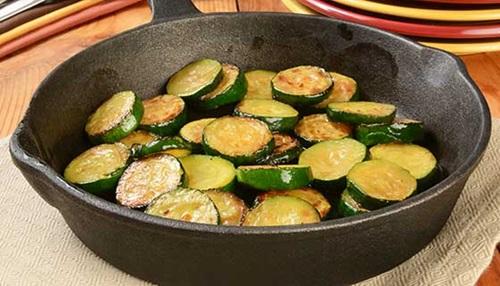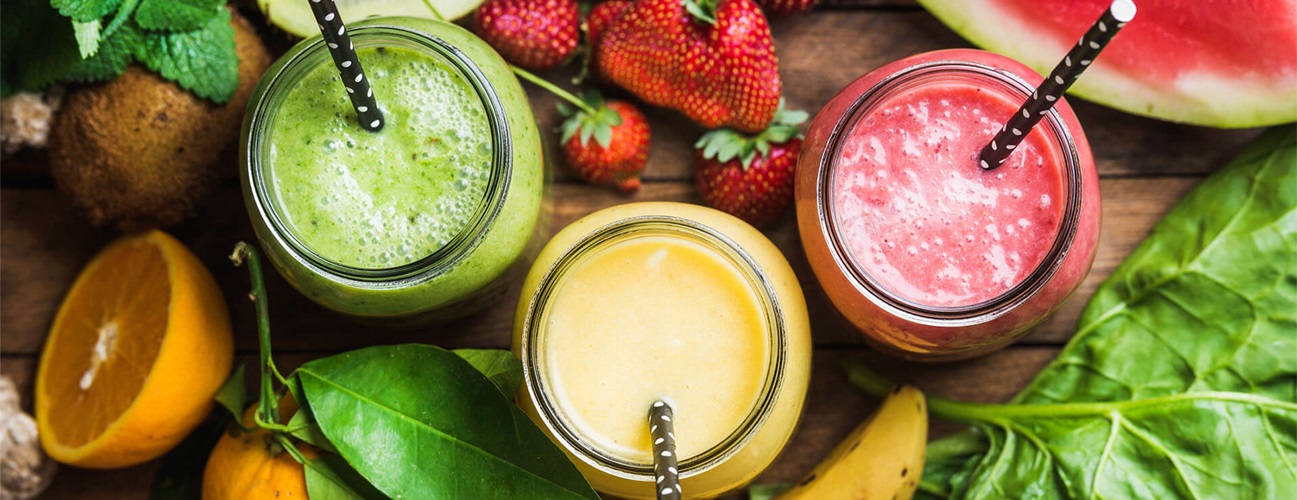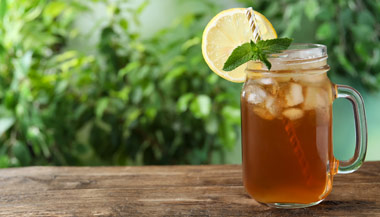How to Make a Healthy Smoothie
Smoothies are popular for good reason. Whirling healthy, whole ingredients together in a blender can give you great nutrition that’s delicious and easy to enjoy on the go.
Dietitian Jordan Spivak from Sibley Memorial Hospital says, “When you make your own at home with ingredients that meet your nutrition needs and taste preferences, smoothies are a great way to get protein, fiber and other nutrients.”
Here are tips for choosing protein powders, fruits, veggies and other ingredients, whether you’re making your own smoothies or ordering at the smoothie shop.
What should I put in a smoothie?
“The great thing about smoothies is how versatile they are,” Spivak says. There are hundreds of different smoothie recipes. For starters, she recommends combining:
- Protein, such as a commercial protein powder, Greek yogurt (which is higher in protein than regular yogurt) or nut butters
- Fruit, including berries, mango, bananas and avocado
- Greens, such as spinach or kale
- A liquid base such as dairy or plant-based milk, water or fruit juice
All types of blenders can work well for smoothie-making. You can use a large-capacity kitchen blender, a personal mini blender or a stick blender that comes with its own cup.
Protein Powder
Protein smoothie recipes often contain protein powder, and Spivak says protein is an important part of a nutritious smoothie. “Protein builds and maintains muscle mass, and can help to keep you feeling full and satisfied,” she says.
Choosing a protein powder can be daunting: Supermarket and health food store shelves are filled with different protein sources, flavors and formats, and as a rule, they’re not inexpensive.
How do you find a protein powder that works for you? Here are some considerations.
Read the Label
Since protein powder is a processed food, it is important to read the label carefully. “If you have food allergies, a careful review of a supplement’s ingredients is essential,” Spivak says.
“You can also find out how much protein and carbohydrates are in the mix and if it contains added sugars, artificial flavors or anything else that you may personally want to avoid due to allergy or intolerance, such as dairy or soy.”
Whey Protein Powder
Spivak says whey protein tops her list of recommended protein powder types because it is the most easily absorbed by the body.
Whey is a liquid byproduct of manufacturing dairy milk products such as cheese. Drying this liquid leaves behind the protein, which can be powdered and flavored.
Proteins are made up of building-block molecules called amino acids. One amino acid is called leucine. “Whey protein contains more leucine than other protein supplement sources,” she explains.
Leucine helps the body several ways, including:
- Providing energy to the muscles during exercise
- Helping create new proteins that build muscle
- Supporting tissue healing
Assisting in metabolism (the process of breaking food down for energy and nutrients)
Whey Protein Side Effects
Using whey protein as directed is generally safe, but if you have a history of intolerance to dairy or other animal proteins, you may experience undesirable side effects such as:
- An upset stomach
- Increased frequency of bowel movements
- Acne
- Increased thirst
- Tiredness
- Bloating
- Headaches
If you experience any of these side effects, stop using the powder and check in with your doctor or dietitian.
Vegan Protein Powder Types
Vegans can choose from a range of plant-based protein powders. Pea protein powder is one example. Other ingredients may include seeds, brown rice, soy or hemp.
“Most plant proteins are not as easily absorbed by the body,” Spivak says, but of the vegetable-based protein sources, pea protein is the one she recommends.
Other Sources for Protein Smoothies
Here are some add-ons to boost the protein content of your smoothie:
Yogurt
Yogurt is a classic smoothie ingredient, but ingredients and flavors vary widely. Some yogurt products are dessert-level sweet, so Spivak says check the label and choose those lower in added sugar for a healthier smoothie.
Spivak favors Greek yogurt to make a smoothie richer in probiotics (healthy bacteria that support gut health) and protein. Icelandic skyr or any Greek yogurt are two of the higher protein options you can find at your grocery store.
Vegan options are available, too, and some of these offer both probiotics and great taste. Try yogurts made from almonds, cashews, coconut, soy or other nondairy sources.
Peanut Butter
Rich in protein, healthy fats, calories and flavor, peanut butter or other nut butters in a smoothie can help you feel full and satisfied.
Seeds
For those with peanut allergies or sensitivity, Spivak says sunflower seed butter can be a tasty substitute. Likewise, ground flaxseeds are another good source of protein, with added benefits of heart-healthy omega-3 fatty acids and fiber.
How much protein should you put in a smoothie? Is there such a thing as too much?
“Protein requirements differ from person to person,” Spivak says. “When you’re using a prepared protein powder, the serving guidelines on the label, such as one or two scoops, are a good starting point.”
She notes that people with certain health conditions may need more protein than average ― or less. Remember, in addition to protein powder, other items such as seeds, nut butter and Greek yogurt can also up the protein content.
“For a better estimate of how much protein is best for you, consult with a dietitian who can take your total health and nutrition goals into account,” she says.
Healthy Choices for Fruit Smoothie Recipes
Whole fruits in a blender beat fruit juice, which delivers concentrated sugar and less fiber. Spivak says that fruits are rich in flavonoids (natural compounds that give fruits their color) that work as antioxidants, reducing inflammation and supporting cellular health.
“Each fruit or vegetable offers something unique in terms of nutrients, so feel free to mix them up and get variety in your smoothie,” she says.
Here are some to try:
- Raspberries, blueberries and strawberries ― fresh or frozen ― are packed with vitamins and fiber, and add appealing color and flavor.
- Bananas contain potassium and a fiber called inulin that helps you feel full and satisfied.
- Mangos are delicious, and supply plenty of fiber and vitamin A.
- Avocado (technically a fruit) can give smoothies a luscious, creamy texture while also adding fiber. Avocados are an alternative to yogurt for people following a vegan diet.
“It should be noted that fruit contains carbohydrates, which can impact blood sugar levels, so it is best to consult with a dietitian on what carbohydrate amounts are best for your personalized nutrition needs,” Spivak advises.
Vegetables for Smoothies
Smoothies are a wonderful way to ensure you’re getting daily vegetables.
- Carrots are a classic choice for delicious sweetness, appealing color and vitamin A, especially when combined with fresh ginger.
- Cucumber helps you stay hydrated, and adds a refreshing veggie boost to summertime smoothies.
- Beets add color, minerals and natural sweetness.
- Cauliflower tends to take on the flavors of whatever it’s combined with, so it can add fiber and vitamins you won’t even notice. Using frozen cauliflower can help make your smoothie cold and refreshing.
- Cooked sweet potatoes can turn a smoothie into a rich, creamy, vitamin-rich delight.
Recipe: Nut Butter and Banana Smoothie
Blend together:
- 2 tablespoons of peanut, almond or sunflower butter
- 1 frozen or fresh banana
- 1 scoop of vanilla or chocolate protein powder
- ½ cup of vanilla Greek yogurt (or vanilla coconut yogurt as a dairy alternative)
- 1 cup of liquid base (water or milk/milk alternatives such as almond or cashew milk — “I like almond milk best,” Spivak says.)
- 1 tablespoon of ground flaxseed
- A few ice cubes
Nutrition facts per one serving: 482 calories, 41 grams of carbohydrates, 37.4 grams of protein, 22.3 grams of fat. NOTE: Nutrition facts will vary depending on brands used, amounts and types of ingredients.
Green Smoothie Ingredients
Green smoothies are an easy, tasty way to get the vitamins, minerals and fiber of fresh greens into your diet. “To add an extra serving of veggies to any smoothie, add in a bunch of kale or spinach to get some extra micronutrients,” she advises.
Spivak says that adding spinach or kale to green smoothie recipes doesn’t mean they have to end up tasting like a pureed salad. “When you blend a handful of green leafy vegetables with fruit and other ingredients, a green smoothie can be delicious.
“Spinach is a good choice to start with. It adds the green color, but has a mild flavor and lots of nutrients. Kale tends to be more fibrous in texture, but is wonderful in smoothies when you take care to blend it thoroughly,” she says.
You can also try:
- Arugula
- Collard greens
- Chard
- Wheatgrass
Recipe: Berry Green Smoothie
Blend together:
- 1 cup of frozen mixed berries
- A generous handful of spinach (frozen or fresh)
- 1 scoop of vanilla protein powder
- ½ cup of vanilla Greek yogurt (or vanilla coconut yogurt as a dairy alternative)
- 1 cup of base liquid (water or milk/milk alternatives such as almond or cashew milk)
- 1 tablespoon of ground flaxseed
- A few ice cubes
Nutrition facts per one serving: 303 calories, 35.8 grams of carbs, 30.4 grams of protein, 6.8 grams of fat. NOTE: Nutrition facts will vary depending on brands used, amounts and types of ingredients.
Not Just for Breakfast
While smoothies are often associated with breakfast, Spivak notes that they can serve as a fast, nutritious meal replacement or a healthy snack. Spivak notes it is best to consult with a dietitian to ensure your smoothie recipes and nutrition content are in line with your personal health goals.
“If you make a big smoothie in a large-capacity blender, you can divide it into smaller servings and freeze or refrigerate them so they’re ready when you need some fast nutritious fuel on the go.
“Also, smoothie ingredients are easy to keep on hand. Frozen fruit and greens keep for a long time and are frozen at their peak, so they are very high quality in terms of vitamins, minerals and other nutrients.”
More Smoothie Recipes:
Fit Facts | Food and Nutrition
Believe it or not, snacks can be part of a healthy diet. Smart Snacking helps you avoid over-eating later in the day.
Diet tips, guides and trends








